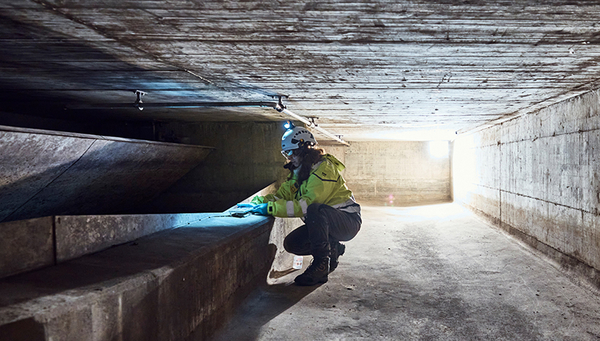News Detail
Cutting-edge research underground
March 11, 2024 |
“What happens to the contents of the toilet after you have flushed it?” This is how Jörg Rieckermann summarises the key question for research in the “Urban Water Observatory” in Fehraltorf, or UWO for short. Rieckermann is a group leader at the aquatic research institute Eawag and project leader of the UWO, which was set up by Eawag in 2016 together with the ETH Zurich. As simple as the question he formulated sounds, we still don’t know exactly how the quantity and composition of wastewater flow change. It’s different in Fehraltorf. The UWO team has set up a measuring network there, in which over 100 measurement instruments and sensors constantly supply data on precipitation and wastewater.
For a recently published report, the research magazine “Horizons” accompanied Eawag’s UWO team during its work at Fehraltorf. The report clearly shows how demanding the installation and maintenance of the sensors are – both physically and technically. For instance, researchers sometimes have to descend into narrow shafts to install measurement instruments. A dedicated radio network was set up in Fehraltorf so that measurement data from underground sensors could be transmitted to Eawag. This is unique in Switzerland, explains UWO technician Simon Bloem.
Optimising the management of rainwater and wastewater
Recording wastewater flow in real time in this way is still complex and expensive. The planning of drainage infrastructure in communes and cities is therefore often based on estimates. If these are inaccurate, this can quickly become expensive, for example if oversized pipes are laid where improved control of the system would be sufficient. The team in Fehraltorf is therefore working on further developing the sensors to make them more affordable. Bodies of water would also benefit from this, as the sensor data can be used, for example, to model how to avoid overloading the wastewater treatment plant during heavy rainfall. This reduces the amount of untreated wastewater that ends up in bodies of water.
“In any case, it will become increasingly important in future to retain rainwater in settlements instead of draining it away as quickly as possible,” explains Jörg Rieckermann. This is to be achieved with the help of blue-green infrastructure such as urban wetlands, green roofs or planted retention basins and to mitigate the effects of climate change with heat waves and heavy rainfall in urban areas. At the same time, this “sponge city principle” can also promote biodiversity.
Advancing urban drainage together
The Urban Water Observatory (UWO) of Eawag and the ETH Zurich in Fehraltorf is also available to experts from research and practice throughout Europe. As part of the EU project “CoUDLabs”, 17 field laboratories for urban drainage from seven European countries have joined forces to make these infrastructures widely accessible and to promote exchange between experts.
Cover picture: Environmental engineer Lena Mutzner installs a passive sampler in an overflow basin to find out how many micropollutants are entering the water. (Photo: Christian Grund / 13Photo)
Video
Developed for the UWO, the wastewater ball “Squid” (which stands for Sewage Quality Instrumental Device) floats in the wastewater and measures chemical and physical parameters of the wastewater.
Cooperations
- ETH Zürich
- Gemeinde Fehraltorf

